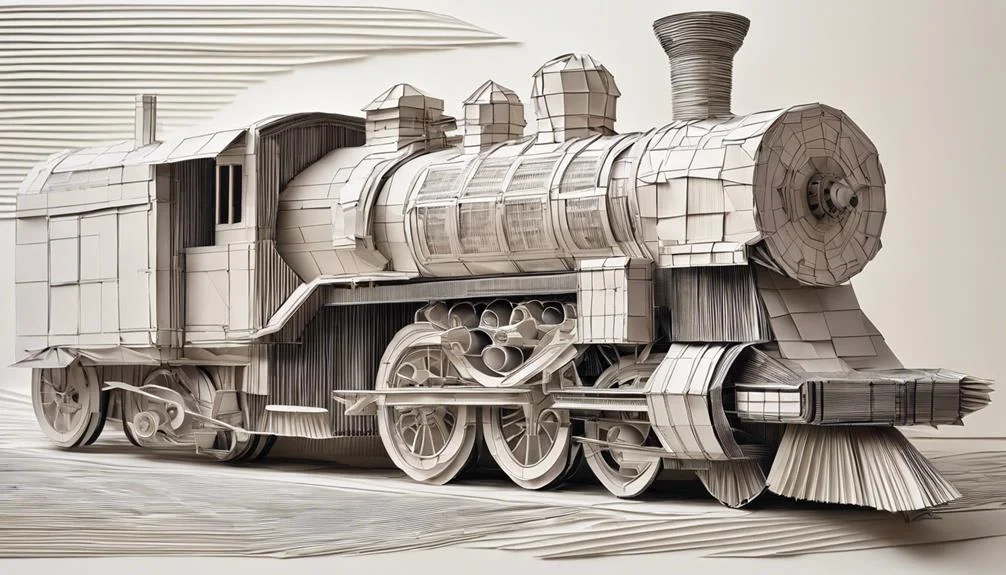The pros of steam engines are, they offer high efficiency and modularity, allowing for lower costs and easy expansion. Steam engines’ multifuel capability enables usage of various fuels, enhancing flexibility and adaptability.
The cons of steam engines are, they demand significant space, maintenance, and operate ineffectively with non-constant loads. Additionally, steam locomotives produce considerable smoke, require frequent water, and extensive operational expertise.
Takeaways:
- Steam engines powered the Industrial Revolution, significantly enhancing production and transportation efficiency.
- They contributed to environmental degradation through air and water pollution.
- The steam engine’s innovation led to job creation and accelerated industrial and urban growth.
- Introduced the challenge of balancing technological progress with environmental stewardship.
| Pros of Steam Engines | Cons of Steam Engines |
|---|---|
| High efficiency | Space requirements |
| Modularity | Performance under non-constant loads |
| Multifuel capability | High maintenance needs |
| Historical impact | Environmental impact |
| Versatility | Fuel consumption |
| Robustness | Water usage |
| Simplicity of design | Need for qualified personnel |
| Economic benefits | Continuous water treatment |
| Educational value | Limited temperature range |
| Cultural heritage | Complexity compared to alternatives |
Pros of Steam Engines
- Efficiency: Steam engines are known for their high efficiency and high degree of utilization, which translates into lower operating costs over time. The ability to convert heat into mechanical energy efficiently makes steam engines suitable for various industrial applications. For instance, in historical contexts, steam engines powered factories, trains, and ships, demonstrating their utility in driving the Industrial Revolution.
- Modularity: The design of steam systems allows for easy extension in a modular fashion, which means that as demand or capacity requirements increase, additional units can be added without significant reengineering of the existing system. This modularity was particularly advantageous in industrial settings where scalability was essential for growth and adaptation to increasing production demands.
- Multifuel capability: Steam engines can operate on a wide range of fuels, from coal and wood to oil and biofuels. This flexibility allowed them to be used in diverse geographic and economic conditions, ensuring a steady supply of fuel regardless of local resources. For example, steam locomotives could be modified to burn whatever fuel was most available and economical, reducing dependency on a single fuel source.
- Historical impact: Steam engines played a pivotal role in the Industrial Revolution, transforming societies and economies worldwide. They enabled mass production, reduced manual labor, and made transportation of goods and people faster and more efficient. This historical significance underscores their transformative power and enduring legacy in shaping modern industry and infrastructure.
- Versatility: Beyond their use in locomotives and industry, steam engines found applications in various fields, including maritime and agricultural settings. Steamships and steam-powered farm equipment like tractors and threshers demonstrate the engine’s adaptability to different tasks and environments, showcasing its versatility.
- Robustness: Steam engines are known for their durability and robustness, capable of operating under harsh conditions for extended periods. This resilience made them particularly valuable in early industrial and transportation applications, where reliability was crucial.
- Simplicity of design: Despite their complexity in operation, the basic principles and design of steam engines are straightforward, which facilitated widespread adoption and maintenance. This simplicity helped in educating a workforce capable of operating and repairing steam engines, contributing to their extensive use.
- Economic benefits: The initial development and use of steam engines spurred economic growth by increasing production efficiency and lowering costs in various sectors. This economic boost was critical in developing nations and regions, providing a foundation for further industrialization and economic expansion.
- Educational value: The operation and mechanics of steam engines offer valuable educational opportunities in physics and engineering. Understanding how steam engines work can provide insights into thermodynamics, mechanical engineering, and historical technological advancements, making them a rich subject for study and instruction.
- Cultural heritage: Steam engines hold a significant place in cultural heritage and history, with preserved locomotives and steam machinery attracting enthusiasts and tourists. This preservation of steam technology offers a tangible link to the past, educating current and future generations about the technological advancements that shaped the modern world.
Cons of Steam Engines
- Space requirements: Steam engines, particularly locomotives, require a lot of space for their operation and storage. This demand for space can be a significant drawback in densely populated areas or where real estate is at a premium. The space needed for tracks, stations, and maintenance facilities often necessitated significant land use planning and investment.
- Performance under non-constant loads: Steam engines do not perform well with non-constant loads, which can limit their efficiency in applications where load demands vary widely. This limitation made them less suitable for tasks that required rapid adjustments in power output, affecting their adaptability to certain industrial processes.
- High maintenance needs: The operation of steam locomotives involves significant maintenance, particularly due to their use of dirty fuels like coal. The accumulation of soot, ash, and other residues necessitates frequent cleaning and maintenance to ensure efficient operation, increasing the overall cost and labor required for their upkeep.
- Environmental impact: The production of smoke, cinders, and embers, especially from coal and wood-burning steam engines, poses significant environmental and health risks. The air pollution generated by these engines contributed to smog and poor air quality in industrial areas, impacting public health and the environment.
- Fuel consumption: Steam locomotives are known for their high fuel consumption relative to the power they produce. This inefficiency in fuel use not only increased operational costs but also contributed to greater environmental degradation through the extraction and burning of large quantities of fuel.
- Water usage: The operation of steam engines requires large amounts of fresh water, necessitating frequent stops for water in locomotive applications. This dependency on water sources limited the routes steam trains could take and added to the operational complexity, especially in arid regions or during long-distance travel.
- Need for qualified personnel: The operation of steam engines requires skilled and qualified personnel, which can be a significant drawback in regions with a shortage of trained workers. The complexity of managing steam pressure, temperature, and mechanical components necessitates a high level of expertise, limiting accessibility to this technology.
- Continuous water treatment: To prevent scale and corrosion in steam engines, continuous water treatment is necessary. This process involves additional costs and complexity in operation, as the water quality must be meticulously managed to ensure the longevity and efficiency of the engine.
- Limited temperature range: Steam systems are not suitable for applications requiring cooling or very high temperatures beyond the limits of saturated or superheated steam systems. This limitation restricts their use in certain industrial processes that require temperatures outside the operational range of steam engines.
- Complexity compared to alternatives: Although steam engines were revolutionary in their time, they are considered more complicated than modern alternatives like diesel engines. The operational complexity, along with the need for constant attention and maintenance, makes steam engines less practical for many contemporary applications, leading to their gradual replacement by more efficient and user-friendly technologies.
Historical Significance
The steam engine, a cornerstone of the Industrial Revolution, fundamentally transformed production processes and enabled the era of mass production. With James Watt’s enhancements in 1765, the steam engine’s efficiency and applicability across various industries were significantly improved. This leap in technology not only facilitated the mechanization of work previously done by hand or animal power but also marked the beginning of a new age in manufacturing and transportation.
The advent of steam-powered locomotives and steamships revolutionized global trade and transportation, making it faster and more efficient than ever before. This not only expanded markets and reduced the costs of goods but also played a crucial role in the integration of global economies. Moreover, the establishment of steam-powered electrical power plants was a direct result of the widespread adoption of steam engines, further fueling industrial growth and innovation.
The historical significance of the steam engine cannot be overstated. It served as a pivotal force in shaping the modern industrial society, laying the groundwork for future technological advancements. Its impact on production processes, transportation, and global trade established a new paradigm in industrialization, heralding an era of unprecedented economic growth and societal change.
Technological Innovations

Building upon its historical significance, steam engine technology underwent a series of innovations that markedly enhanced its efficiency and broadened its industrial utility. These advancements transformed the steam engine from a novel invention into a cornerstone of industrial power, driving machinery in factories, mills, and later, locomotives and ships.
Key innovations that propelled the evolution of steam engine technology include:
- The separate condenser by James Watt, which significantly improved the efficiency of steam engines by reducing energy loss during the condensation process.
- The incorporation of throttle valves and speed governors, mechanisms that enhanced control over engine speed and power output, ensuring more stable and efficient operation.
- The development of double-acting pistons and rotative engines, which expanded the industrial applications of steam power beyond simple pumping actions to power a variety of machinery.
These technological innovations, alongside advancements like the parallel motion and sun and planet gear systems, not only improved the functionality and versatility of steam engines but also paved the way for their widespread adoption across different sectors. The cumulative effect of these improvements was a dramatic increase in the utility and efficiency of steam power, setting the stage for its pivotal role in the industrial age.
Industrialization Impact

Steam engines’ introduction to the industrial landscape marked a profound transformation in manufacturing and transportation, fundamentally altering production and societal structures. By revolutionizing production during the Industrial Revolution, steam engines made it feasible and more economical to mass-produce goods. This shift not only changed the way products were made but also significantly impacted the scale and speed at which they were produced. Factories that harnessed the power of steam engines experienced a notable increase in efficiency, which translated into heightened productivity levels.
Moreover, the ability to power machines and vehicles allowed for the global transportation of goods and people, transforming the operational dynamics of societies. This newfound mobility facilitated the expansion of markets and the exchange of ideas on an unprecedented scale. The widespread adoption of steam power heralded a significant shift in manufacturing processes and transportation methods, laying the foundation for modern industrial economies.
Steam engines, by powering the machines and vehicles essential for mass production and transport, played a pivotal role in driving the Industrial Revolution. Their influence extended beyond the economic sphere, reshaping social structures and paving the way for the development of the contemporary world.
Environmental Concerns

While steam engines propelled the Industrial Revolution, their operation also ushered in significant environmental challenges, notably pollution and poor air quality. The wide adoption of steam engines was a double-edged sword, enabling unprecedented economic growth while simultaneously degrading the environment. The environmental concerns associated with steam engines are multifaceted, impacting not just the air, but also water quality and living conditions in densely populated urban areas.
Key environmental concerns include:
- Air Quality Degradation: Steam engines emitted large amounts of carbon dioxide and other pollutants, significantly compromising air quality. This not only affected the health of populations in industrial and urban areas but also contributed to broader climate concerns.
- Polluted Waterways: The operation of steam engines and the industries they powered often led to the discharge of pollutants into rivers and streams, affecting water quality and marine life.
- Adverse Living Conditions: The proliferation of steam engines in urban areas, coupled with the pollution they generated, led to poor living conditions. This was characterized by smog-filled skies, polluted water sources, and a general decline in the quality of life for residents in these areas.
The environmental legacy of steam engines is a testament to the complex relationship between industrial progress and environmental stewardship.
Transportation Evolution

The evolution of transportation has been significantly marked by the introduction and development of the steam engine, overcoming early transportation challenges through its reliability and power.
This pivotal technology not only enhanced the speed and capacity of travel and trade but also laid the groundwork for future shifts in mobility, paving the way for modern infrastructure and technological progress.
As we explore the impacts of steam engines, we also consider the ongoing evolution towards more sustainable and efficient forms of transportation.
Early Transportation Challenges
Navigating the landscape of early transportation presented significant challenges, particularly with the limitations inherent in steam engine technology. These engines, revolutionary as they were, faced significant hurdles that affected their efficiency and widespread adoption.
Among the myriad of challenges, three stand out for their notable impact on the early days of steam-powered transportation:
- Steam engines required frequent stops for refueling with coal or water, significantly impacting their efficiency and operational range.
- The lack of proper roads and infrastructure severely hindered the widespread use and practicality of steam-driven vehicles, which were often bulky and cumbersome.
- Adapting to varying terrains and weather conditions was a struggle, affecting the reliability and functionality of early steam engines in diverse environments.
Steam Engine Impact
Despite facing early challenges, the steam engine significantly altered the landscape of transportation, marking the beginning of a new era in the movement of goods and people. By enabling faster and more efficient travel, it revolutionized how distances were perceived and conquered.
The introduction of steam-powered locomotives, ships, and early automobiles facilitated the expansion of railway networks and maritime routes, connecting previously isolated regions and fueling unprecedented economic growth. This transformation made travel less arduous and more accessible, laying the groundwork for the modern transportation systems we rely on today.
Moreover, the steam engine’s influence extended beyond immediate technological advancements, shaping the design and operation of vehicles for centuries and establishing a foundation from which future innovations would emerge.
Future Mobility Shifts
Advancements in technology and a growing awareness of environmental concerns are driving a significant evolution in the field of transportation, steering society towards more sustainable and efficient future mobility solutions. This shift is characterized by several key developments:
- The proliferation of electric vehicles, which offer a cleaner alternative to traditional internal combustion engines, significantly reducing greenhouse gas emissions and air pollution.
- Major improvements in battery technology, enabling electric vehicles to travel longer distances on a single charge and reducing the time required for recharging.
- The advent of innovative transportation options such as autonomous vehicles and high-speed rail systems, which promise to revolutionize mobility by enhancing efficiency, safety, and convenience, while also supporting sustainable urban planning efforts that prioritize public transportation, cycling, and pedestrian-friendly spaces.
Economic Effects

Exploring the economic effects of the steam engine reveals a multifaceted impact on society.
The advent of steam technology not only catalyzed industrial growth, marking a significant shift in production and business models, but it also prompted a reevaluation of environmental costs associated with rapid industrialization.
Furthermore, its role in job creation and the reshaping of labor markets underscores its profound influence on the economic landscape.
Job Creation Impact
The advent of steam engines significantly catalyzed job creation, fundamentally altering the economic landscape by paving the way for industrial and urban development. This groundbreaking technology not only created a plethora of job opportunities but also spurred a shift from agricultural to more diverse industrial economies. The transformation was profound, with several key impacts:
- Numerous job opportunities emerged in industries such as manufacturing and transportation, leading to increased employment rates.
- Urban migration intensified as people moved to cities in search of work, transforming small communities into bustling urban centers.
- The diversification of employment options away from agriculture towards more industrial and service-oriented roles reshaped the job landscape.
Such changes underscored the pivotal role steam engines played in the economic transformation of societies, fostering a new era of industrialization and urbanization.
Industrial Growth Acceleration
As steam engines became more prevalent, they served as a catalyst for unprecedented industrial growth, significantly enhancing production efficiency and economic output. This revolution in industrial capability was marked by a substantial increase in the production efficiency and capacity of factories.
The introduction of steam engines not only led to a significant rise in industrial output but also spurred economic expansion on a scale previously unseen. With the ability to facilitate mass production of goods, steam engines drove economic growth throughout the Industrial Revolution.
Factories that harnessed the power of steam experienced a transformative increase in productivity, altering the manufacturing landscape forever. Consequently, the widespread adoption of steam engines accelerated the emergence of large-scale industries and factories, marking a new era in industrial and economic development.
Environmental Cost Consideration
While steam engines catalyzed industrial and economic growth, they also introduced significant environmental costs and sustainability challenges that require careful consideration. The repercussions of their widespread use have been profound, impacting both the environment and the socio-economic conditions of the era.
- Significant pollution from carbon dioxide emissions, affecting air quality and contributing to global environmental concerns.
- Poor living conditions exacerbated by polluted rivers and reduced air quality, highlighting the direct impact of steam engine operations on human health and the environment.
- Economic reliance on industries that supported poor working conditions and the rampant use of child labor, as evidenced by the findings of the Sadler Committee, illustrating the darker aspects of industrialization driven by steam power.
These factors underscore the urgent need for cleaner energy sources and more sustainable industrial practices.
Modern Legacy

Reflecting on the profound impact of steam engines, it’s evident that their legacy extends far beyond their initial mechanical applications, influencing both technological innovations like the telephone and electric lighting, as well as the very structure of modern economies and work practices. The transformative power of steam engines is not merely historical; it has laid the foundation for the evolution of mass business models that revolutionized daily life and work routines across Europe. This revolution was not confined to technological advancements but extended to socio-economic realms, introducing hourly wages that enhanced efficiency and simplified the tracking of pay for workers.
The advent of steam engines significantly lowered the cost of goods, thereby increasing disposable income amongst the general population and encouraging spending on leisure activities. This economic shift not only improved the quality of life but also catalyzed the creation of a consumer-driven market. By 1800, the proliferation of steam engines in Great Britain had become a cornerstone for the global economy, illustrating the enduring influence of this technology. The legacy of steam engines, therefore, encompasses a wide array of advancements and societal shifts, shaping the modern world in myriad ways.
Conclusion
In sum, the steam engine significantly shaped the course of history, catalyzing technological advancements and industrialization.
While its contribution to the evolution of transportation and the economy cannot be understated, it is imperative to acknowledge the environmental repercussions and technical limitations associated with its use.
The legacy of the steam engine, therefore, embodies a complex interplay of innovation and challenge, urging a nuanced appreciation of its role in shaping modern society and the ongoing quest for sustainable technological advancements.










